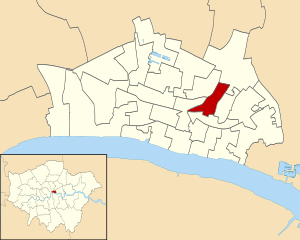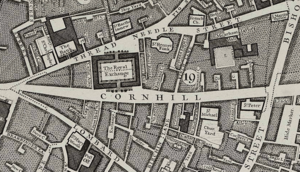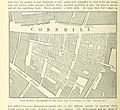Cornhill, London facts for kids
Quick facts for kids Ward of Cornhill |
|
|---|---|
 Location within the City |
|
| OS grid reference | TQ327811 |
| Sui generis | |
| Administrative area | Greater London |
| Region | |
| Country | England |
| Sovereign state | United Kingdom |
| Post town | LONDON |
| Postcode district | EC3 |
| Dialling code | 020 |
| Police | City of London |
| Fire | London |
| Ambulance | London |
| EU Parliament | London |
| UK Parliament |
|
| London Assembly | |
Cornhill is a special area, called a ward, and a street in the City of London. This is the very old and important part of London, England, where many financial businesses are located. The street runs between Bank Junction and Leadenhall Street.
The name Cornhill comes from a hill. This hill is one of London's three oldest hills. The other two are Tower Hill, where the famous Tower of London stands, and Ludgate Hill, topped by St Paul's Cathedral. The highest point of Cornhill is about 17.7 meters (58 feet) above sea level.
History of Cornhill
Cornhill is one of the traditional areas that make up the City of London. The street is home to two churches designed by the famous architect Sir Christopher Wren. These are St. Michael, Cornhill and St Peter upon Cornhill. People believe St Peter upon Cornhill is the oldest Christian site in London.
Both churches are built on the site of the old Roman market, or Londinium forum. At one end, Cornhill meets several other important streets like Threadneedle Street and Lombard Street at Bank junction.
The first Royal Exchange, a famous trading center built by Sir Thomas Gresham, was on Cornhill. The building that replaced it, designed by William Tite, now faces the Bank of England.
In 1582, the "Standard" was built near Cornhill and Leadenhall Street. This was London's first public water supply that used a machine to pump water. Water was pumped from the River Thames through lead pipes to four taps. This service stopped in 1603. This spot became a starting point for measuring distances to and from London. You might still see its name on old mileposts.
In 1652, Pasqua Rosée opened London's very first coffeehouse. It was located in St. Michael's Alley, just off Cornhill.
The publishers Smith, Elder and Co were based at 65 Cornhill. They published a popular magazine called The Cornhill Magazine from 1860 to 1975. They also published the Dictionary of National Biography. The magazine was first edited by William Makepeace Thackeray.
Cornhill Street is also famous from books! It's the address of the "Scrooge and Marley" counting house in Charles Dicken's 1843 story, A Christmas Carol. This is where Bob Cratchit worked.
Cornhill Today
Today, Cornhill is often linked with opticians and companies that make optical tools. These include things like microscopes and telescopes.
A statue of the engineer James Henry Greathead was put up in 1994. It stands near the Royal Exchange, which is part of the Cornhill ward. Underneath the street, you can find the world's first underground public toilet. It opened in 1855. People had to pay a small fee of one penny to use it. This is said to be where the saying "spend a penny" comes from!
Cornhill was part of the route for the 2012 Olympic and Paralympic Games marathons. The women's Olympic marathon was on August 5th, and the men's was on August 12th. The four Paralympic marathons took place on September 9th.
The postcode for the street is EC3V.
How Cornhill Helps Choose City Leaders
Cornhill is one of 25 wards in the City of London. Each ward chooses an Alderman for the Court of Aldermen. They also choose Commoners, who are like councillors, for the Court of Common Council. These groups help run the City of London Corporation. Only people who are Freemen of the City of London can run for these positions.
The current Alderman for Cornhill is Robert Howard. The current Common Council members are Peter Dunphy (who is also a Deputy), Joanna Abeyie, and Ian Seaton. They were chosen without opposition in 2022.
Images for kids









